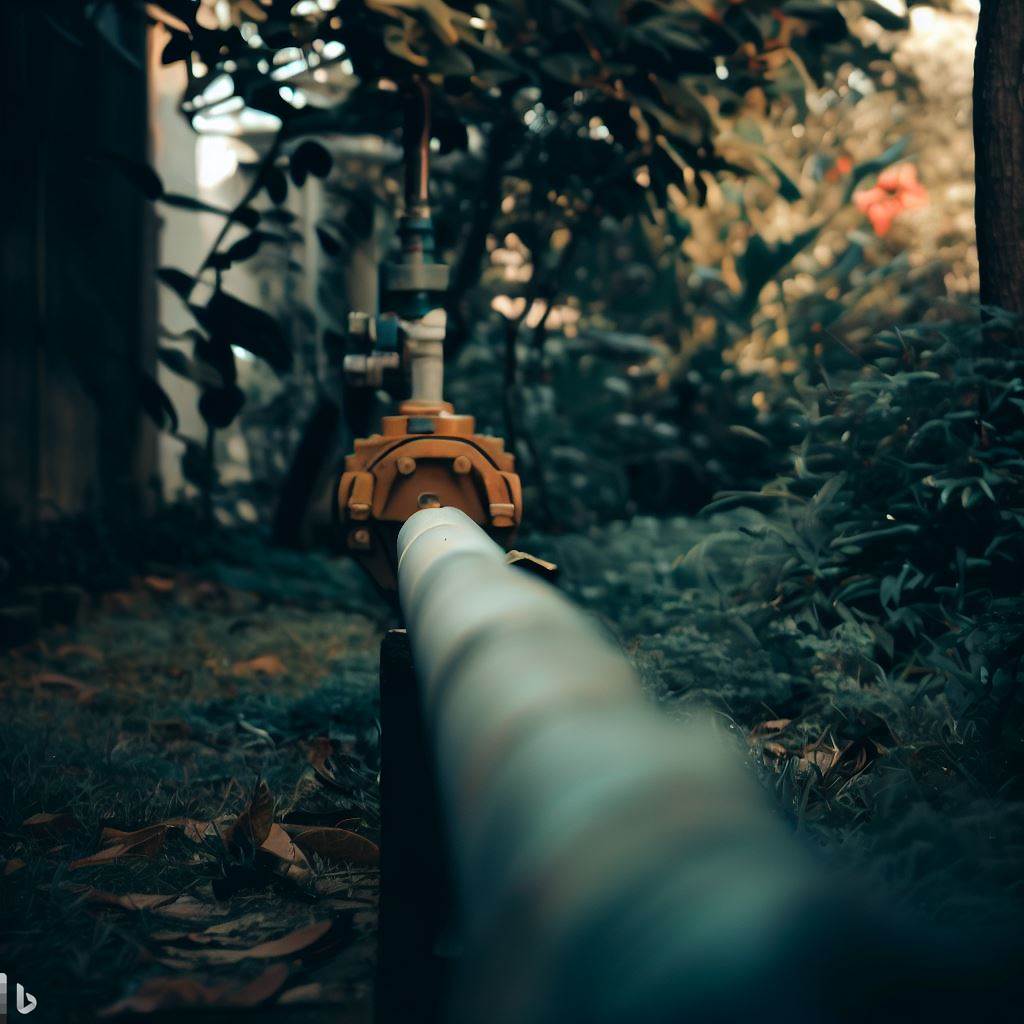Are you waging a silent war with the underground ‘gas line in backyard’ troubleshoot? You’re not alone. We’ve all had those puzzling moments, standing over that little patch of ground, scratching our heads, and wondering what’s exactly happening beneath our feet. Perhaps you have even found yourself pondering about the complexities of installing or maintaining a gas line. Well, let’s unravel this mystery together.
In this comprehensive post, we’ll plunge into the world of gas line in the backyard, covering everything you need to know. From the installation process to maintenance do’s and don’ts, as well as essential safety precautions to bear in mind, we’ve got you covered!
No more feeling like Sherlock Holmes investigating a curious case every time your BBQ refuses to light up due because of faulty pipeline issues! So come on board for an illuminating ride through Gasville– let’s journey from confusionville to clarity-land together!
How to Safely Install and Maintain Your Gas Line in Backyard
So you decide to expand your backyard oasis, perhaps by adding a cozy fire pit or installing a new outdoor kitchen. Excitement fills the air as you envision all the wonderful memories you’ll create in your enhanced outdoor space.

But before you start digging into those grand plans, it’s crucial to understand one important thing – the presence of a gas line lurking beneath your yard.
Identifying the Exact Location of a Gas Line in the Backyard
Ah, the mystery of pinpointing that elusive gas line! The first step towards ensuring safety is knowing where it hides. Now, let me warn you, my friend – finding that hidden treasure can be quite challenging at times. Maybe not as challenging as grilling shrimp without skewers but you get the point.
However, fear not! With some patience and sleuthing skills up your sleeve, nothing can stop you from locating that pesky ‘gas line in backyard’ dilemma.
One way to go about this enthralling adventure is by contacting your local utility company. They possess superpowers (also known as maps) that show where these underground lines are located. Reach out to them and request assistance in uncovering the true position of your precious gas line.
Procedures to Safely Dig Near a Gas Line
Now comes an exciting part – digging near the gas line without any hiccups! Picture yourself dancing gracefully with each shovelful while keeping an eye out for potential dangers lurking below.
To ensure maximum safety during excavation endeavors near a gas line, follow these simple yet essential steps:
1. Acquire knowledge like Indiana Jones
Before embarking on any digging adventure worthy of Hollywood action films, educate yourself about safe practices when working around gas lines! Familiarize yourself with proper dig depths and distances required from these vital underground arteries.
2. Dial 811 like it’s nobody’s business
My dear reader, take advantage of this magical telephone number known as 811. By contacting them, you’ll notify all utility companies in your area about your plans to dig, prompting them to come and mark the exact location of their precious lines before you let loose with that shovel.
3. Befriend a shovel whisperer
Choose your digging tool wisely, my friend! Opt for hand tools like shovels instead of power equipment when working near gas lines. These gentle yet sturdy companions allow you to retain control and prevent any unwanted accidents that can cause a hissing gas line or worse – a catastrophe!
Preventive Measures to Avoid Hitting a Gas Line While Gardening or Construction
You’ve got green thumbs and construction dreams, but the thought of accidentally piercing that hidden treasure beneath might leave you feeling more terrified than delighted.
Fear not, brave explorer! By implementing these preventive measures while gardening or undertaking construction projects in your backyard palace, you’ll be able to sidestep the perilous path towards potential gas line damage:
1. Keep those tools in check: Maintain an inventory of all underground utilities running through your yard so that no garden gnome goes rogue on unsuspecting buried infrastructure.
2. Mark it like Picasso: Prioritize marking any areas where gas lines reside by using visible markers such as flags or paint before starting work on any project involving soil disturbance.
3. Nurture thy plants with caution: When planting shrubs or trees near gas lines, choose varieties with shallow root systems and plant them at locations where they won’t interfere with these vital pipelines—no root intrusions allowed!
4. Be cautious: Whether you’re using a hickory nut sheller or working on a gas line, caution cannot be overemphasized. Proceed slowly and cautiously when using mechanized equipment for excavation purposes if there’s even an inkling of doubt about the true whereabouts of those sneaky underground pipes.
What To Do If You Accidentally Hit a Backyard Gas Line
So, you’ve followed all the preventative measures, but oops! A ghastly incident has occurred – you’ve managed to hit that gas line buried beneath your backyard utopia. Stay calm, my dear reader. While it may seem like a nightmare come true, there are steps you can take to swiftly rectify the situation.
1. Exit with haste: First and foremost, evacuate the area immediately if you suspect any damage to a gas line. Your safety and that of those around you must always be paramount.
2. Call for reinforcements: Contact your local utility company or emergency services right away to report the damage and seek their professional assistance in resolving the issue promptly.
3. Nay on naked flames: Do not engage in activities that could ignite an open flame when near a damaged gas line – we don’t want your backyard party turning into an inferno!
4. Spread awareness among neighbors: Alert nearby residents about the situation so they can also exercise caution until professionals arrive to resolve the issue.
Legal Implications and Regulations Around Homeowner Gas Lines
Before diving deeper into this intriguing topic of gas lines in our backyards, it is essential to address the legal implications surrounding homeowner responsibilities concerning these hidden marvels.
While regulations vary from region to region, many jurisdictions hold homeowners accountable for maintaining portions of gas lines on their property past a specific point (often referred to as “point of ownership”). Therefore, it’s prudent for every responsible homeowner – yes, that means you –to familiarize themselves with relevant laws pertaining to their individual circumstances.
Methods for Repairing Damaged Backyard Gas Lines
No worries if disaster strikes and your backyard becomes ground zero for a damaged gas line catastrophe! Professional help is here at your service—never fear!
Repairing damaged backyard gas lines requires specialized knowledge and expertise best left in skilled hands:
1. Call upon trained specialists: Reach out to licensed gas line repair professionals who possess the knowledge and skills needed to handle such sensitive repairs with finesse.
2. Safety first, always: Before beginning any repair work, ensure that all potential hazards are adequately addressed and mitigated. The last thing we want is to escalate a minor incident into something far more dangerous.
Professional Services for Installation, Maintenance, and Inspection of Homeowner’s Gas Lines
Remember my friend – you don’t have to navigate this exhilarating world of gas lines alone! Professional services abound for those seeking assistance in installing, maintaining, or inspecting their homeowner’s gas lines.

1. Installing peace of mind: When it comes to installing new gas lines or extending existing ones in our backyard oasis, professionals can safely bring our visions to life while ensuring adherence to quality standards and legal requirements.
2. Maintaining the invisible guardians: Regular maintenance is key in keeping your underground warriors functioning optimally. Trust the experts’ trained eyes – they’ll be able to detect any signs of trouble before it escalates into costly disasters.
Conclusion
Mastering the art of safely installing and maintaining a gas line in your backyard opens up endless possibilities for enjoyment and relaxation while eliminating unnecessary risks that lie beneath the surface soil.
By taking necessary precautions during excavation projects near these vital arteries and seeking professional help when needed – you’ll ensure your outdoor sanctuary remains not only beautiful but also safe from menacing leaks that could shatter your dreams like fragile glass.
So go forth now armed with knowledge and confidence! Your backyard masterpiece awaits its transformation into an inviting haven where laughter echoes through warm summer nights amidst glowing fire pits—safely powered by underground marvels that keep us cozy even on chilly evenings.
Read other exciting blog posts here on either the intriguing question, has a hummingbird ever killed a human or the exciting art of making half a hog cuts.
FAQs
Q: What is natural gas?
A: Natural gas is a fossil fuel that is primarily composed of methane. It is commonly used as a fuel source for heating, cooking, and electricity generation.
Q: What is a natural gas line?
A: A natural gas line refers to a pipe or tubing system that is used to transport natural gas from a gas company’s main distribution line to individual homes or buildings.
Q: How do I install a gas line in my backyard?
A: Installing a gas line in your backyard should be done by a professional plumber or a licensed contractor who is experienced in working with natural gas systems. They will ensure that all codes and safety regulations are followed, and the installation is done properly.
Q: Can I install a natural gas line myself?
A: It is highly recommended to hire a professional to install a natural gas line. Natural gas systems can be complicated and dangerous if not installed correctly. It is best to leave this job to a qualified professional who can ensure the safety of the installation.
Q: Do I need a permit to install a natural gas line?
A: Yes, in most areas, a permit is required to install a natural gas line. This ensures that the installation is done according to local codes and safety standards. It is important to check with your local building department to determine the specific requirements for obtaining a permit.
Q: How often should I have my natural gas line inspected?
A: It is recommended to have your natural gas line inspected by a professional every one to two years. This will help detect any potential leaks or issues and ensure the safe operation of your gas system.
Q: What should I do if I suspect a natural gas leak?
A: If you suspect a natural gas leak, it is important to take immediate action. Leave the area immediately and avoid creating any sparks or flames. Call your gas company’s emergency line and let them know about the suspected leak. They will send a technician to assess the situation and resolve any potential hazards.
Q: How can I maintain my natural gas line?
A: Regular maintenance of your natural gas line is important to ensure its safe operation. This includes checking for any signs of corrosion or damage, ensuring proper ventilation around gas appliances, and scheduling regular inspections by a professional.
Q: Can I use a natural gas line for my outdoor grill?
A: Yes, a natural gas line can be installed to supply fuel to an outdoor grill. This eliminates the need for propane tanks and allows for a continuous fuel supply while grilling.
Q: How much does it cost to install a natural gas line in my backyard?
A: The cost of installing a natural gas line in your backyard can vary depending on several factors, such as the distance from the main gas line, the complexity of the installation, and local labor costs. It is best to contact a professional plumber or contractor for an accurate cost estimate specific to your project.



